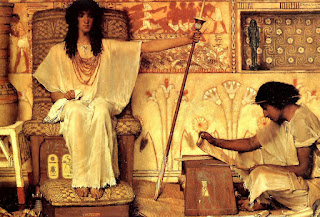Jewish midrash, Hellenistic romance, and the coded manual of a Mystery school?
The divine double, or heavenly twin, one of my favorite themes in the history of religion. In a recent study, The Greatest Mirror: Heavenly Counterparts in the Jewish Pseudepigrapha (Albany, NY: SUNY Press, 2018) Andrei A. Orlov tracks it through the Pseudepigrapha ("False Writings") the name given to a mostly Jewish body of texts from late antiquity whose authorship and provenance is disguised or concealed.
Most interesting is the story of Aseneth, the high-born daughter of the chief priest of Heliopolis who is married to Joseph, the dreamer and patriarch. Her tale grows and grows from a few lines in Genesis through midrash and imagination until it becomes a popular Greek romance novel - and maybe also a coded manual for a Mystery school. In the two Greek-language versions of her story Aseneth receives a visitation from an angelic being who looks exactly like Joseph except that he flashes with fire and lightning. He feeds her mysterious honeycomb from his mouth and she is infused with divine essence and wisdom. When she looks in the mirror of water and sees the face of another radiant being, apparently her own divine double, who is named as Metanoia.
In
its shorter and longer versions, Aseneth (as the scholar Ross Kraemer suggests
we call it) is distinguished by the prominence it gives to the life and spiritual
transformation of a woman, and to the appearance (very rare in Jewish texts) of
a female angel who also happens to be her divine double.
In the Book of Genesis, Aseneth is the
daughter of a powerful Egyptian priest. Pharaoh gives her to Joseph as a wife
and she bears him two sons, Manasseh and Ephraim.
In Greek texts written somewhere between 100 and 350
ce, with versions in several other languages – the story was clearly popular – her
tale expands into an ancient romance novel.
Though amazingly beautiful herself, she is awed by
Joseph’s glorious appearance when he arrives at her father’s house (the priest
is called Petiphres in Greek) in a gold chariot drawn by four white horses. Her
father calls her down and wants her to marry him. She holds back and Joseph
says he can’t marry someone wedded to idols. Aseneth is infatuated, she throws
her magical statues and power objects out the window of her tower (yes, she has
a tower) and dresses herself in sackcloth and ashes.
Now a mystical being appears to her. She is terrified.
He blazes with fire and lightning. He also looks just like Joseph except for the light
show. We learn that he is Joseph’s heavenly twin and an angel who can look at
the Face of God. Joseph’s divine double tells the Egyptian girl to take off her
veil and her black garment, to wash her face with “living water” and to dress
in fresh linen. She exposes herself to
him in a way she has never done with a man. There is an erotic charge in the
scene.
The visitor then instructs her to bring a honeycomb she
did not know was in her storehouse. When she finds it, he eats some and she
asks him to feed her from his mouth. A transfer of spiritual power takes place
when Aseneth receives the honeycomb from the mouth of that heavenly being - who
of course has a heavenly voice and is identified as the Angel of the Name. Then
beautiful golden and purple bees fly upwards, impossibly, from the honeycomb.
Next the bees fall dead but immediately rise again.
The whole scene has an erotic charge but we discover
it is about initiation and spiritual marriage. Aseneth is going to find her own
heavenly double whose name is Metanoia (literally, Change of Mind), translated
as Repentance in Christian-influenced texts but better translated, I think, as
Transformation. At the end of his visit – before her physical marriage to Joseph
– the heavenly victor tells her to put on her wedding dress.
When her father sees her, he says “your face is
fallen”. Dismayed, she looks in a mirror of water. She sees that her beauty is
greater than before, Her lips are “roses of life”, Her breasts are “mountains
of God.” When she turns from the mirror, her father sees the change too and
falls at her feet in reverence.
Later we get required elements in a bodice ripper. Attempted rape by Pharaoh’s son, abetted by two of Joseph’s bad brothers, foiled by Joseph’s good brothers (breaking with gene, Joseph isn’t in the scene).
The image
Sir Lawrence Alma-Tadema's painting of "Joseph, Overseer of Pharaoh’s Granaries" shows an Egyptian lady of power who may be Aseneth.


No comments:
Post a Comment